Elite athletes have long benefited from soft tissue massage, which can reduce stiffness and soreness. Recreational athletes such as scuba divers can use foam rollers — which are readily accessible in most fitness and training centers, homes and physical therapy facilities — to make self-massage accessible and affordable.
Foam rollers are available for purchase at local sports stores or online in a variety of densities, sizes and shapes to meet individual levels of comfort and tolerance. You may want to begin with a less dense foam roller and progress to a firmer roller as your tolerance increases. Although foam rolling may cause discomfort, it should never cause bruising. Always listen to your body and adjust as needed.
Scuba divers can incorporate foam rolling before or after regular workouts. Prior to a workout, rolling may improve the warmup by decreasing the muscles’ density and priming them for static stretching or your regular warmup and workout. Rolling after a workout may aid recovery by decreasing soreness while adding only five minutes to your routine. Stretching also strengthens the muscles used to support your body.
Try to add foam rolling at least three times per week. Start as described, and slowly roll up and down each muscle for 30 to 60 seconds. When you hit a tender spot (trigger point), hold the muscle in that position for a few seconds until tension begins to subside.
Quadriceps Roll
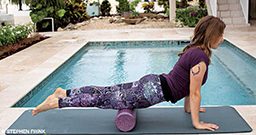
- Begin in plank position with your upper thigh resting on the roller.
- Roll the length of your quadriceps, using your elbows to guide the movement.
Tip: Try to apply steady strokes the full length of the muscle.
Challenge: Try crossing one leg over the other and rolling the middle, outside and inside of each quadriceps.
Tibialis Anterior

This is a good rolling technique to alleviate shin splints.
- Begin with the roller under the shins close to the ankle.
- Lift and support your body while rolling toward the knee and returning to the starting position.
Tip: If the pressure is initially too much, use a softer surface such as a bed or a soft, carpeted area. Stop before the roller reaches your knees, which can be uncomfortable and aggravate the injury.
Challenge: If needed, add pressure by placing more weight on one leg.
Hip Adductors (Inner Thighs)
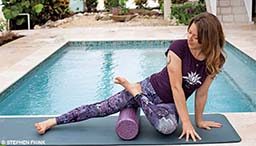
- Lie on your side with your upper leg resting on the roller.
- Cross your lower leg over the upper thigh, with your foot resting above the knee.
- Roll from above the knee to mid-thigh.
Hamstring Roll
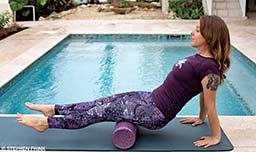
- Begin in a seated position with the roller under your thigh.
- Lift your upper body with your hands directly below your shoulders.
- Roll the length of the hamstrings by moving backward and returning to the starting position.
Tip: Relax your muscles as you roll.
Challenge: If you have sufficient strength, you can cross one leg over the other, placing greater tension on the roller.
Calf Roll
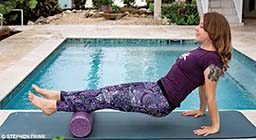
Begin in the same starting position as the hamstring roll, but place the roller in the middle of your calves.
Roll the entire length of the muscle, stopping briefly at tender areas.
Tip: If you have difficulty supporting your body weight (or want to target the inside and outside of your calf area), roll one calf at a time by placing the opposite foot on the floor as support.
Challenge: Cross the feet to add more pressure to one leg.
Hip Abductors (Outer Thighs)
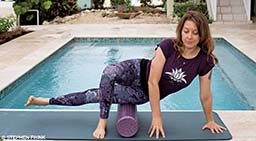
- Lie on your side with the roller mid-thigh.
- Cross your top leg over while supporting your weight on the lower arm directly under the shoulder.
- Roll from the hip to just above the knee.
Tip: Never roll across or on a joint, especially the knee.
Piriformis

The piriformis is a deep muscle below the gluteal muscles. Imbalances or tightness in this muscle can cause hip and lower-back issues.
- Sit on the foam roller.
- Cross one leg over the other, and lean toward the crossed leg to rest on the piriformis.
- Support your upper body with the same arm as the crossed leg. Roll over the piriformis, using a small range of motion.
Upper Back

Rolling the upper back feels great and releases tension in the posterior muscles.
- Lie on your back with the roller just below your shoulder blades.
- Bend your knees, plant your feet, lift your bottom and roll toward your head while supporting your weight on extended hands.
- Maintain a neutral spine: Don’t strain or roll your neck.
Challenge: Fold your arms across your chest to reach the deeper muscles (rhomboids) of the upper back. Raising your hips will also place more pressure on areas in need.
NOTE: To avoid an increased risk of decompression sickness, DAN® recommends that divers avoid strenuous exercise for 24 hours after making a dive. During your annual physical exam or following any changes in your health status, consult your physician to ensure you have medical clearance to dive.
© Alert Diver — Q3 Summer 2018